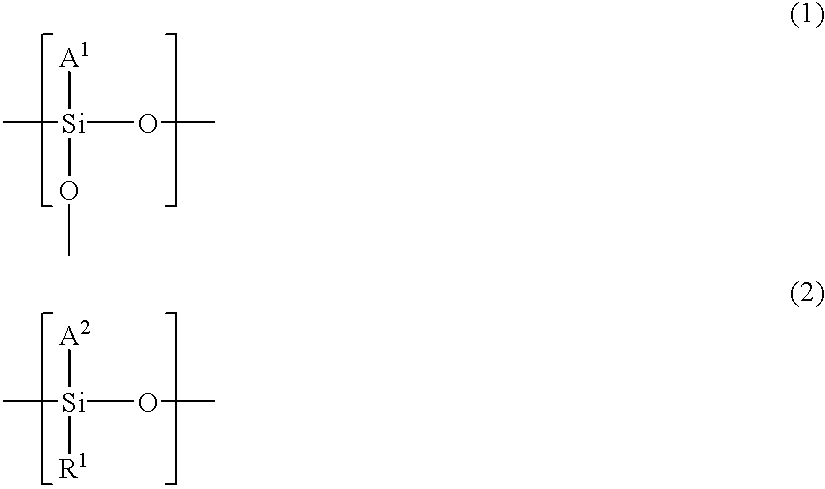Radiation-sensitive resin composition
a technology of radiofrequency and resin, applied in the direction of photosensitive materials, instruments, photomechanical equipment, etc., can solve the problems of resolution performance, inability to provide high accuracy of excimer laser using these resins, and insufficient resolution performance of conventional resist materials using siloxane polymers
- Summary
- Abstract
- Description
- Claims
- Application Information
AI Technical Summary
Problems solved by technology
Method used
Image
Examples
synthesis example 1
Synthesis of Polysiloxane (α)
[0196]A three-necked flask equipped with a stirrer, a reflux condenser, and a thermometer was charged with 8.34 g of the compound of the following formula (30), 12.92 g of the compound of the following formula (31), 8.75 g of methyltriethoxysilane, 30 g of 4-methyl-2-pentanone, and 7.20 g of a 1.75 wt % aqueous solution of oxalic acid. The mixture was reacted for 6 hours at 80° C. while stirring, followed by cooling with ice to terminate the reaction. The reaction solution was poured into a separating funnel to remove the water layer. The organic layer was repeatedly washed with ion-exchanged water until the reaction solution became neutral. The solvent was evaporated under reduced pressure from the organic layer to obtain 18.5 g of a polysiloxane (α).
[0197]
wherein the silicon atom bonds to the 3-position or 4-position of the tetracyclo[4.4.0.12,5.17,10]dodecane ring.
[0198]
wherein the silicon atom bonds to the 2-position or 3-position of the bicyclo[2.2....
synthesis example 2
Synthesis of Polysiloxane (α)
[0204]A three-necked flask equipped with a stirrer, a reflux condenser, and a thermometer was charged with 3.84 g of the compound of the above formula (30), 7.93 g of the compound of the above formula (31), 3.22 g of methyltriethoxysilane, 15 g of 4-methyl-2-pentanone, and 3.32 g of a 1.75 wt % aqueous solution of oxalic acid. The mixture was reacted for 6 hours at 80° C. while stirring, followed by cooling with ice to terminate the reaction. The reaction solution was poured into a separating funnel to remove the water layer. The organic layer was repeatedly washed with ion-exchanged water until the reaction solution became neutral. The solvent was evaporated under reduced pressure from the organic layer to obtain 8.24 g of a polysiloxane (α).
[0205]1H-NMR spectrum (chemical shift σ), Mw, and Mn of the polysiloxane (α) were measured. The results were as follows.[0206]σ: 2.3 ppm (CH2C(CF3)2 group), 1.4 ppm (t-butyl group), 0.2 ppm (SiCH3 group)
[0207]Mw: 2,...
synthesis example 3
Synthesis of Polysiloxane (α)
[0210]A three-necked flask equipped with a stirrer, a reflux condenser, and a thermometer was charged with 1.90 g of the compound of the above formula (30), 6.89 g of the compound of the above formula (31), 1.21 g of methyltriethoxysilane, 10 g of 4-methyl-2-pentanone, and 1.65 g of a 1.75 wt % aqueous solution of oxalic acid. The mixture was reacted for 10 hours at 40° C. while stirring, followed by cooling with ice to terminate the reaction. The reaction solution was poured into a separating funnel to remove the water layer. The organic layer was repeatedly washed with ion-exchanged water until the reaction solution became neutral. The solvent was evaporated under reduced pressure from the organic layer to obtain 7.5 g of a viscous oily resin. The resin had an Mw of 1,500 and an Mw / Mn ratio of 1.1.
[0211]The resin was dissolved in 22.5 g of 4-methyl-2-pentanone. After the addition of 2.43 g of distilled water and 3.40 g of triethylamine, the mixture was...
PUM
| Property | Measurement | Unit |
|---|---|---|
| Glass transition temperature | aaaaa | aaaaa |
| Fraction | aaaaa | aaaaa |
| Percent by mass | aaaaa | aaaaa |
Abstract
Description
Claims
Application Information
 Login to View More
Login to View More - R&D
- Intellectual Property
- Life Sciences
- Materials
- Tech Scout
- Unparalleled Data Quality
- Higher Quality Content
- 60% Fewer Hallucinations
Browse by: Latest US Patents, China's latest patents, Technical Efficacy Thesaurus, Application Domain, Technology Topic, Popular Technical Reports.
© 2025 PatSnap. All rights reserved.Legal|Privacy policy|Modern Slavery Act Transparency Statement|Sitemap|About US| Contact US: help@patsnap.com



